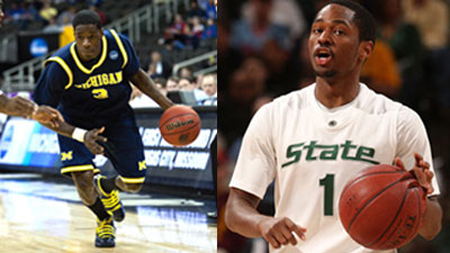
Without saying a word this site has ended up in the middle of a debate: who’s the better point guard, Michigan State’s Kalin Lucas or Michigan’s Manny Harris.
John Gasaway started the debate on this very site with this comment on Manny Harris:
In fact, I want to pipe up on behalf of one of your players. I read the interview you did with KJ of The Only Colors and I have to take issue with your statement that Michigan State’s Kalin Lucas “is easily the best point guard in the conference.” Really? What about a certain Manny Harris? Oh, I know last year there were always other Wolverines on the floor alongside Harris who proudly wore the “point guard” label (Kelvin Grady, C.J. Lee, Stu Douglass, etc.). I for one don’t buy it. Harris had by far the highest assist rate on the team and, more importantly, he ran this offense in the literal Beilein-ian sense. Plus Lucas is hapless inside the arc, making an anemic 40 percent of his twos last year. I’ll grant you that Lucas made Sherron Collins look really bad at a propitious moment (less than a minute left in a tie game) in the Sweet 16 and is clearly superior to Harris when it comes to nailing threes. I’m just sayin’. Not open and shut from my chair.
KJ ran the numbers to try to determine a winner. Looking at only conference numbers, KJ concludes that Lucas has the advantage in the point guard battle because he turns the ball over less and shot much better from three point range. The other two stats that KJ looked at were assist and free throw rates, which turned out to be roughly equivalent.
The most interesting point that KJ makes is that Kalin Lucas morphs into whatever Michigan State needs him to be based on the opponent:
Against non-Big Ten foes, Lucas fits the mold of the traditional pass-first point guard. He distributes the ball to his teammates, minimizes turnovers, and scores at a relatively modest rate. And it isn’t just a case of padding the ball-handling stats against weaker opposition; the numbers don’t change much if you restrict the sample to nonconference opponents from BCS conferences.
Against Big Ten adversaries, meanwhile, Lucas morphs into a shoot-first point guard. The assist number drops substantially, with an uptick in turnovers, and the scoring average shows an offsetting increase.
Let me state my theory on Lucas in broader (and less emotionally-detached) terms : Kalin Lucas does what his team needs him to do to win games. Against faster-paced opponents, he runs the fast break with superb efficiency. Against more plodding opponents, he finds ways to score in the half-court offense.
I think the moral of the story is that Kalin Lucas and Manny Harris are very different players who somehow come away with similar stat lines because of the role each plays for his team.
Lucas is a pure point guard in every sense of the phrase. Luckily for him, he plays in an offense that relies on a guy like him to control the ball and make plays in the half court offense. When MSU runs, he is able to shift gears and turn into a pass first player, distributing the ball to MSU’s stable of wings in transition.
Michigan, on the other hand, runs a two guard offense that was designed to eliminate the need for a true point guard. Beilein’s offense revolves around spacing and doesn’t call for one player to dominate the ball in the half court set. Manny Harris does a little bit of everything for Michigan but it prevents him from falling into any traditional role. He plays the three but distributes like a point guard, scores like a wing, and attacks the defensive glass like a big man.
I concede that Kalin Lucas is a better point guard than Manny Harris, especially in Big Ten play when Lucas snapped out of his early season funk. But I think the most impressive point here is that Manny had a higher assist rate in conference play than one of the top point guards in the country. Not to mention that Harris’ defensive rebounding percentage in conference games was in the same league as Big10 rebounding elites such as Joe Krabbenhoft, Mike Davis, and Paul Carter.
The obvious argument against Harris’ remarkable statistical well-roundedness is that he is forced to do everything as a product of his teams’ flaws. For example, Brian Cook points out that his rebounding is merely a function of being the second tallest player on his team. Maybe so, but I have a hard time believing that Harris wouldn’t be a tremendous defensive rebounder for any school in the country.








